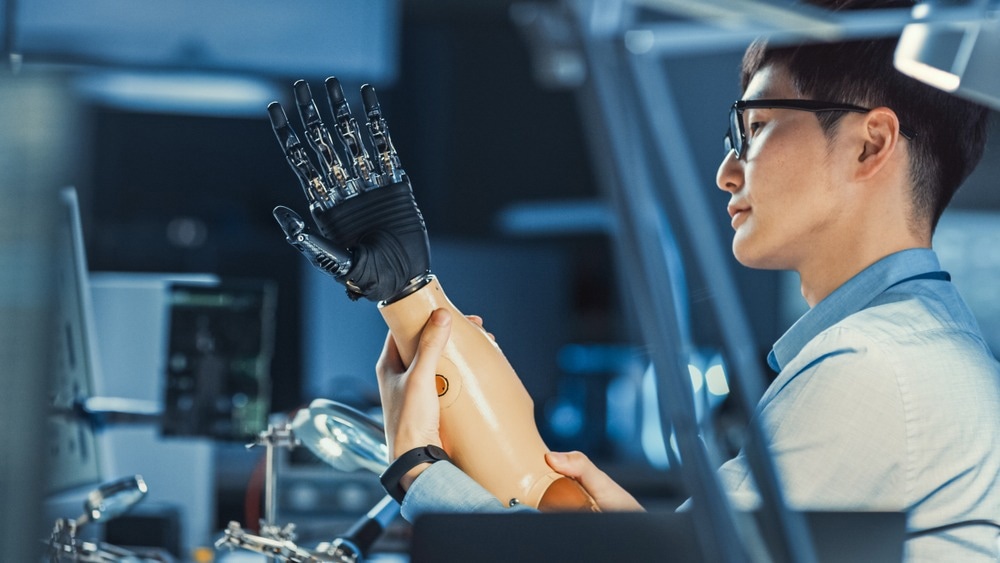Here, we discuss some recent and upcoming developments in the use of biomorphic robotics in healthcare.

Image Credit: Gorodenkoff/Shutterstock.com
Recent and Upcoming Advances in Prosthetic Limb Design
An estimated 3.6 million Americans will live with a lost limb in the year 2050, mainly resulting from trauma and closely followed by vascular disease as a cause, most of which could benefit from prosthetic devices in leading independent lives.
On the other hand, prosthesis abandonment is as high as around 25% in the adult population and higher amongst pediatric patients; the most commonly reported reasons for abandonment include discomfort, residual limb pain, and functional superfluity; in many cases, adapting to using the body differently to compensate for a lost limb is more convenient than learning to use an external device as a limb.
Myoelectric prostheses are those with electronic components that can interpret electrical signals from muscles in the limb to induce mechanical motion, such as flexing the hand, though issues with electrode-skin contact can make these devices impractical during everyday use while sweating, and so on.
Within the last decade, more deeply integrated electrodes that directly anchor into the skin and communicate with the prosthetic by disconnectable metal-metal electrode contact have been explored. These devices transmit electrical signals transdermally from the muscles and provide a much more reliable connection than traditional ex vivo electrodes.
Electrical devices that connect directly to nerves are also under investigation and would allow almost seamless biomorphic robotic prostheses in terms of user-prosthetic interaction. Small studies where virtual prosthetic hands were attached to either the ulnar or median nerve have shown that patients were able to regain control of individual fingers, though this technology is still in its infancy.
Synthetic and Artificial Skin
Robot, synthetic, or artificial skin has been explored as wound dressings and prosthetic replacements, emulating the touch, feel, flexibility, and appearance of ordinary skin.
Artificial skin typically refers to prosthetic skin made entirely of non-biotic materials, often using photolithography on flexible silicon-based materials to imprint a circuit into the material, allowing for the incorporation of electrical equipment capable of interpreting sensation. This can be achieved using two fine layers of charged material that touch to differing degrees in response to pressure and thus deliver differing electrical charges.
In the future, highly adaptable 2D electronic materials such as graphene may be utilized in prosthetics and allow unprecedented sensing possibilities. Highly biocompatible, strong, and flexible materials such as collagen and spider silk have been widely explored as artificial skin, though mainly as wound healing agents. Interwoven materials such as spider silk can be laid down in very thin layers while incorporating electronic signaling and sensing components between layers.
Biotic synthetic skin can also be grown from cells on a collagen scaffold, including incorporated vasculature and other details. In order to maximize biocompatibility, the patient’s own cells can be used as seeds and thus produce a genetically identical piece of tissue, which can be surgically grafted in place. Many biotechnology firms utilize automated processes facilitated by robots that administer the growth of the three-dimensional cell culture.
What is Necrobotics?
Necrobotics incorporates biological material from deceased organisms with mechanical components, with numerous applications in research and as prosthetic devices. Traditional prosthetics fail to replicate human sensations, and thus, transplanted materials, namely skin, though potentially other organs that may benefit from some mechanical component, could be more thoroughly incorporated into prosthetic devices in the future.
Rehabilitation robots intended for comfort therapy or companionship would also benefit in terms of realism from the use of muscles, tendons, skin and hair, and potentially other biotic components.
Along the same vein, and in less relevant examples of necrobotics, various animals and animal parts could make effective robot chassis themselves. Any creature bearing a strong exoskeleton, such as cockroaches, crabs, or scorpions, could be the basis for small, resilient, and adaptable robots that could inconspicuously reach otherwise hard-to-enter locations, such as disaster sites.
The pincers and stinger of these animals could be used as manipulative devices, or where more soft dexterity is required animals such as octopuses could be used. Where the full biological output of an animal can be interpreted by technology, the senses of the organism could potentially also be utilized from a robotic perspective.
For example, the ability of fish to detect toxins in water could be exploited in environmental monitoring, the flight and vision of birds in rescue operations, and so on.
Various ethical considerations exist regarding necrobotics, and in many cases, the question of whether necrobotic construction is any better or cheaper than the non-biotic, entirely mechanical counterpart remains.
References and Further Reading
Ray, P.R. (2023). An Introduction to Necrobotics: Concept, Architecture, Use Cases, Challenges, Future Directions. SSRN. Available at: https://papers.ssrn.com/sol3/papers.cfm?abstract_id=4595801
Bates, T. J., et al. (2020). Technological Advances in Prosthesis Design and Rehabilitation Following Upper Extremity Limb Loss. Current Reviews in Musculoskeletal Medicine, 13(4), pp. 485–493. doi.org/10.1007/s12178-020-09656-6
Leventon, W. (2002). Synthetic skin. IEEE Spectrum, 39(12). doi.org/10.1109/MSPEC.2002.108844
Disclaimer: The views expressed here are those of the author expressed in their private capacity and do not necessarily represent the views of AZoM.com Limited T/A AZoNetwork the owner and operator of this website. This disclaimer forms part of the Terms and conditions of use of this website.